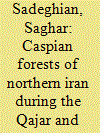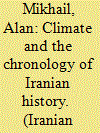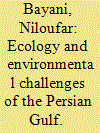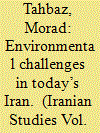|
|
|
Sort Order |
|
|
|
Items / Page
|
|
|
|
|
|
|
| Srl | Item |
| 1 |
ID:
148811


|
|
|
|
|
| Summary/Abstract |
Uniquely among the world’s temperate forests, much of the vegetation of the Caspian forests is now endangered. But while deforestation has accelerated in Iran, these processes were actually underway in the nineteenth century. This article offers a brief introduction to the history of forest exploitation and concessions during the Qajar and Pahlavi periods, addressing actions taken by the Iranian state to protect and extend forest cover, but also the deficiencies of that legislation and the reasons for its failure. Though it is one of the most forested countries in the Middle East, Iran’s forests remain understudied. Existing scholarship mostly addresses the contemporary period; this paper extends the scope of our knowledge, offering a deeper history of forest exploitation in Iran.
|
|
|
|
|
|
|
|
|
|
|
|
|
|
|
|
| 2 |
ID:
148810


|
|
|
|
|
| Summary/Abstract |
This article offers a chronology of climate events in Iran over the last millennium to challenge traditional chronologies of the Iranian past based on politics, war, and economics. Using insights gleaned from the historiography of climate in Iran, and from neighboring regions, especially the Ottoman Empire, four episodes of climate cooling show how climate-induced environmental processes affected more people for longer in Iran than did the policies of the empires ostensibly ruling over them. Thus, the article aims to put climate more squarely on the agenda of historians of Iran so that the conjectures advanced here can be confirmed, revised, or discarded through future empirical research. Moreover, the article seeks to bring Iran into wider conversations in environmental and global history.
|
|
|
|
|
|
|
|
|
|
|
|
|
|
|
|
| 3 |
ID:
148816


|
|
|
|
|
| Summary/Abstract |
Because of its diverse geological formations, climates, and soils, Iran is home to outstanding biodiversity. National conservation started in Iran over fifty years ago and today nearly 10 percent of the country is protected. However, biodiversity in Iran is threatened, with about 100 species of vertebrate fauna vulnerable or endangered. Increased population and human activity, climate change, drought, desertification, agriculture, poaching, and economic sanctions have helped create this crisis. Many of these causes can be mitigated through better planning, sustainable policies, and increased civil society and local engagement. Promoting awareness about the impacts of human practices will also be important for the long-term sustainability of Iran’s ecosystems. Iranian conservation NGOs have already taken an active role in preserving biodiversity.
|
|
|
|
|
|
|
|
|
|
|
|
|
|
|
|
| 4 |
ID:
148813


|
|
|
|
|
| Summary/Abstract |
Iran has a long history of effective and sustainable water resource management under arid and semi-arid conditions. However, today the country is faced with serious challenges in the water sector, including rising water demand and shortages, declining groundwater levels, deteriorating water quality, and increasing threats to the environment and various ecosystems. If these issues persist, tragedy will be the inevitable result. Over the last three decades tremendous efforts have been made to supply water, primarily through an extensive program of development, with dam building at the forefront. This paper offers an introduction to the different factors and elements influencing the water balance in today’s Iran and presents a perspective on the trend of dam building in recent times.
|
|
|
|
|
|
|
|
|
|
|
|
|
|
|
|
| 5 |
ID:
148815


|
|
|
|
|
| Summary/Abstract |
The extreme salinity and temperature fluctuations of the Persian Gulf waters have created unique marine and coastal ecosystems, with numerous benefits to Iran and neighboring countries. However, human activities, including rapid coastal development, land-based pollution, oil and gas extraction, and shipping, are threatening the survival of these ecosystems. With long shorelines, a large coastal population, and locally important fisheries and tourism-related jobs, Iran has a lot at stake in the degradation of its marine and coastal environments. However, it is not too late to put a stop to further degradation. This article recommends a number of targeted actions at the local, national, and regional levels to address the threats to the Persian Gulf ’s environment and protect this important renewable resource.
|
|
|
|
|
|
|
|
|
|
|
|
|
|
|
|
| 6 |
ID:
148808


|
|
|
|
|
| Summary/Abstract |
Even to an untrained eye, Iran’s environmental landscape appears bleak. Drying or dried up lakes, polluted rivers and brooks, thirsty cities with polluted air, sandstorms and bird-less skies, vanishing orchards and gardens in the vicinity of cities and villages, the victims of urban growth, species on the verge of extinction, pasturelands serving as urban wastebaskets, with plastic bags instead of blooming poppies, hazardous wastewaters destroying fish, insects, and humans alike, shrinking forests invaded by cars and villas, or else exploited by the timber industry, and, of course, scarcity of water almost everywhere.
|
|
|
|
|
|
|
|
|
|
|
|
|
|
|
|
| 7 |
ID:
148809


|
|
|
|
|
| Summary/Abstract |
Drought, increased population, war, air pollution, climate change, industrial and agricultural production, sanctions, inefficient water and natural resource use, and lack of enforcement of existing environmental regulations have contributed to Iran’s current environmental crisis. Insufficient water resources are forcing people to migrate, putting pressure on others. Aquifers are being drained. Air pollution has made living conditions in Iran’s cities increasingly challenging. Wind erosion is furthering the desertification of agricultural land, creating greater production demand on remaining arable areas. Biodiversity is under threat. On the other hand, Iran’s environmental future can be positively influenced by the collaboration of the public, private and non-profit sectors. Awareness and education, along with greater financial and human resources, will be necessary to tackle the problem.
|
|
|
|
|
|
|
|
|
|
|
|
|
|
|
|
| 8 |
ID:
148812


|
|
|
|
|
| Summary/Abstract |
Iran is currently experiencing serious water problems. Frequent droughts coupled with over-abstraction of surface and groundwater through a large network of hydraulic infrastructure and deep wells have escalated the nation’s water situation to a critical level. This is evidenced by drying lakes, rivers and wetlands, declining groundwater levels, land subsidence, water quality degradation, soil erosion, desertification and more frequent dust storms. This paper overviews the major drivers of Iran’s water problems. It is argued that while climatic changes and economic sanctions are commonly blamed as the main drivers of water problems, Iran is mainly suffering from a socio-economic drought—i.e. “water bankruptcy,” where water demand exceeds the natural water supply. In theory, this problem can be resolved by re-establishing the balance between water supply and demand through developing additional sources of water supply and implementing aggressive water demand reduction plans. Nevertheless, the current structure of the water governance system in Iran and the absence of a comprehensive understanding of the root causes of the problem leave minimal hope of developing sustainable solutions to Iran’s unprecedented water problems.
|
|
|
|
|
|
|
|
|
|
|
|
|
|
|
|
| 9 |
ID:
148817


|
|
|
|
|
| Summary/Abstract |
In Iran, national parks were originally created to protect wildlife and natural expanses. Over time, the exigencies of handling conflict with the locals and a worldwide shift in management approaches from strict protection to newer participatory approaches led Iranian conservationists to adopt the discourse of participatory conservation. However, serious institutional and attitudinal obstacles have prevented policy makers and officials from developing good relations with local communities, making it difficult to serve the interests of conservation or accommodate tourists. Based on interviews with past and present officials of the Department of the Environment of Iran and other field observers, this paper discusses approaches to conservation that reconcile the requirements of conservation with the needs of the people who benefit from reserves.
|
|
|
|
|
|
|
|
|
|
|
|
|
|
|
|
| 10 |
ID:
148814


|
|
|
|
|
| Summary/Abstract |
Urban air pollution is a major health risk in several large Iranian cities. Transportation, extensive use of fossil fuels, outdated urban fleets of gasoline and diesel vehicles, industrial sources within and close to the city boundaries and natural dust are major contributing factors. Starting with Tehran, emission inventories and mathematical air pollution models are being developed. Air quality is being monitored and reported to the public, though data availability and validity remain a challenge. While national and local air pollution mitigation plans are in place, progress remains slow, coordination is weak, and sources of funding are limited.
|
|
|
|
|
|
|
|
|
|
|
|
|
|
|
|
|
|
|
|
|